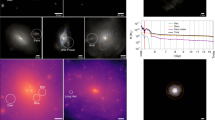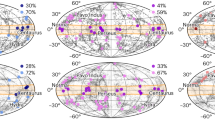Abstract
Observations1,2 indicate that the expansion of the Universe is accelerating, which is attributed to a ‘dark energy’ component that opposes gravity3,4. There is a purely geometric test of the expansion of the Universe (the Alcock–Paczynski test), which would provide an independent way of investigating the abundance ( ) and equation of state (
) and equation of state ( ) of dark energy5. It is based on an analysis of the geometrical distortions expected from comparing the real-space and redshift-space shape of distant cosmic structures, but it has proved difficult to implement6,7,8,9,10,11,12,13,14,15,16,17,18. Here we report an analysis of the symmetry properties of distant pairs of galaxies from archival data19,20. This allows us to determine that the Universe is flat. By alternately fixing its spatial geometry at
) of dark energy5. It is based on an analysis of the geometrical distortions expected from comparing the real-space and redshift-space shape of distant cosmic structures, but it has proved difficult to implement6,7,8,9,10,11,12,13,14,15,16,17,18. Here we report an analysis of the symmetry properties of distant pairs of galaxies from archival data19,20. This allows us to determine that the Universe is flat. By alternately fixing its spatial geometry at  and the dark energy equation-of-state parameter at
and the dark energy equation-of-state parameter at  , and using the results of baryon acoustic oscillations, we can establish at the 68.3% confidence level that
, and using the results of baryon acoustic oscillations, we can establish at the 68.3% confidence level that  and
and  .
.
This is a preview of subscription content, access via your institution
Access options
Subscribe to this journal
Receive 51 print issues and online access
$199.00 per year
only $3.90 per issue
Buy this article
- Purchase on Springer Link
- Instant access to full article PDF
Prices may be subject to local taxes which are calculated during checkout


 .
.
Similar content being viewed by others
References
Riess, A. et al. Observational evidence from supernovae for an accelerating universe and a cosmological constant. Astron. J. 116, 1009–1038 (1998)
Perlmutter, S. et al. Measurements of omega and lambda from 42 high-redshift supernovae. Astrophys. J. 517, 565–586 (1999)
Peebles, P. J. E. & Ratra, B. The cosmological constant and dark energy. Rev. Mod. Phys. 75, 559–606 (2003)
Frieman, J. A., Turner, M. S. & Huterer, D. Dark energy and the accelerating universe. Annu. Rev. Astron. Astrophys. 46, 385–432 (2008)
Alcock, C. & Paczyski, B. An evolution free test for non-zero cosmological constant. Nature 281, 358–359 (1979)
Kim, Y.-R. & Croft, R. A. C. A potentially pure test of cosmic geometry: galaxy clusters and the real space Alcock-Paczynski test. Mon. Not. R. Astron. Soc. 374, 535–546 (2007)
Ryden, B. S. Measuring q0 from the distortions of voids in redshift space. Astrophys. J. 452, 25–32 (1995)
Ryden, B. S. & Melott, A. Voids in real space and in redshift space. Astrophys. J. 470, 160–171 (1996)
Phillips, S. A possible geometric measurement of the cosmological constant. Mon. Not. R. Astron. Soc. 269, 1077–1081 (1994)
Matsubara, T. & Suto, Y. Cosmological redshift distortion of correlation functions as a probe of the density parameter and the cosmological constant. Astrophys. J. 470, 1–5 (1996)
Ballinger, W. E., Peacock, J. & Heavens, A. F. Measuring the cosmological constant with redshift surveys. Mon. Not. R. Astron. Soc. 282, 877–888 (1996)
Popowski, P. A., Weinberg, D. H., Rayden, B. S. & Osmer, P. Quasar clustering and spacetime geometry. Astrophys. J. 498, 11–25 (1998)
Hui, L., Stebbins, A. & Burles, S. A geometrical test of the cosmological energy contents using the Ly-α forest. Astrophys. J. 511, 5–8 (1999)
McDonald, P. Toward a measurement of the cosmological geometry at z ∼ 2: Predicting Lyα forest correlation in three dimensions and the potential of future data. Astrophys. J. 585, 34–51 (2003)
da Angela, J., Outram, P. J. & Shanks, T. Constraining β(z) and Ω m0 from redshift-space distortions in z∼3 galaxy surveys. Mon. Not. R. Astron. Soc. 361, 879–886 (2005)
Nusser, A. The Alcock-Paczynski test in redshifted 21-cm maps. Mon. Not. R. Astron. Soc. 364, 743–750 (2005)
Barkana, R. Separating out the Alcock-Paczynski effect on 21-cm fluctuations. Mon. Not. R. Astron. Soc. 372, 259–264 (2006)
Mc Quinn, M. et al. Cosmological parameter estimation using 21cm radiation from the epoch of reionisation. Astrophys. J. 653, 815–834 (2006)
Abazajian, K. N. et al. The seventh data release of the Sloan Digital Sky Survey. Astrophys. J. Suppl. Ser. 182, 543–558 (2009)
Davis, M. et al. The All-Wavelength Extended Groth Strip International Survey (AEGIS) data sets. Astrophys. J. 660, 1–4 (2007)
Strauss, M. A. & Willick, J. A. The density and peculiar velocity fields of nearby galaxies. Phys. Rep. 261, 271–431 (1995)
Marinoni, C. et al. Galaxy distances in the nearby Universe: corrections for peculiar motions. Astrophys. J. 505, 484–505 (1998)
Marinoni, C., Bel, J. & Buzzi, A. The scale of cosmic isotropy. Phys. Rev. Lett. (submitted)
Coil, A. et al. The DEEP2 Galaxy Redshift Survey: clustering of galaxies in early data. Astrophys. J. 609, 525–538 (2004)
Kessler, R. et al. First year SDSSII supernovae results: Hubble diagram and cosmological parameters. Astrophys. J. Suppl. Ser. 185, 32–84 (2009)
Astier, P. et al. The Supernovae Legacy Survey: measurement of Ωm, ΩΛand w from the first data set. Astron. Astrophys. 447, 31–48 (2006)
Dunkley, J. et al. Five-year Wilkinson Microwave Anisotropy Probe observations: likelihoods and parameters from the WMAP data. Astrophys. J. Suppl. Ser. 180, 306–329 (2009)
Eisenstein, D. J. et al. Detection of the baryon acoustic peak in the large-scale correlation function of SDSS luminous red galaxies. Astrophys. J. 633, 560–574 (2005)
Percival, W. et al. Baryon acoustic oscillations in the Sloan Digital Sky Survey Data Release 7 galaxy sample. Mon. Not. R. Astron. Soc. 401, 2148–2168 (2010)
Acknowledgements
C.M. thanks J. Bel, P.-E. Crouzet, M. Davis, L. Guzzo, A. Blanchard, E. Branchini, P. S. Corasaniti, A. Ealet, A. Heavens, O. Le Fèvre, L. Moscardini, T. Schucker, P. Taxil and J. M. Virey for discussions. We thank R. Giovanelli, L. Lellouch and P. J. Morrison for reading versions of the manuscript. This paper has greatly benefited from the comments of M. Strauss. C.M. is grateful for support from the Projets Exploratoires Pluridisciplinaires: Physique Théorique et ses Interfaces of the CNRS and from specific project funding of the Institut Universitaire de France.
Author information
Authors and Affiliations
Contributions
C.M elaborated the testing formalism. C.M. and A.B. worked on the comparison of theoretical predictions with observations.
Corresponding author
Ethics declarations
Competing interests
The authors declare no competing financial interests.
Additional information
The posterior likelihood shown in Fig. 3 is available at http://www.cpt.univ-mrs.fr/~marinoni/Plik.tar.gz.
Supplementary information
Supplementary Information
The file contains Supplementary Text and Data I-VI, additional references, Supplementary Table 1 and Supplementary Figures 1-5 with legends. (PDF 1200 kb)
Rights and permissions
About this article
Cite this article
Marinoni, C., Buzzi, A. A geometric measure of dark energy with pairs of galaxies. Nature 468, 539–541 (2010). https://doi.org/10.1038/nature09577
Received:
Accepted:
Published:
Issue Date:
DOI: https://doi.org/10.1038/nature09577
This article is cited by
-
Cosmological parameter estimation from large-scale structure deep learning
Science China Physics, Mechanics & Astronomy (2020)
-
Geometry of the Universe
Nature (2010)
-
Dark energy on firmer footing
Nature (2010)
Comments
By submitting a comment you agree to abide by our Terms and Community Guidelines. If you find something abusive or that does not comply with our terms or guidelines please flag it as inappropriate.



